
Banner made by me, using Canva
All the images from the banner are from @splinterlands
English
Introduction
The Trample is an extremely interesting ability that only works for cards that have a melee attack.

It means that when an opponent's monster is eliminated by the holder of the ability, an extra attack can be made on the next monster in line. This means that if this situation occurs with a card that is in the last position on the field, this additional attack will not take place.
In any case, it's worth using them whenever possible. Preferably by placing a monster with Taunt in the back line, to hold off the opposing team so that they can survive longer, and so have a better chance of being able to carry out more attacks.
But what if these extra attacks could be carried out several times in a row? That's what can happen when the Stampede ruleset is present.

If each of the monsters attacked is eliminated and the attacker has Trample, the number of attacks will be unlimited until one of them manages to hold it off.

Battle Analysis
In the battle where I found this rule, there were two others:
Super Sneak: all Meele-type monsters get the ability Sneak, attacking the last monster in the back line.

Target Practice: Range and Magic monsters have the ability Snipe, making them attack the first monster in the back line that isn't Meele.

With that, there were several things I needed to pay attention to:
First: the ruleset of the weekly challenge would be useless, since Trample attacks the next monster on the field, but if that monster is the last one in the back row, there is no other monster to attack after it, invalidating the ability and therefore the ruleset. The only way it could work would be to put a monster with Trample on the front line or for the last monster on the back line to be one with the ability Camouflage, causing the second-to-last one to be attacked, so there's a chance of that happening. However, I didn't find it that interesting.
It's worth noting that the ability Sneak overrides all the other abilities the Meeles have, so they all attack the last monster in the back line, regardless of which ability they have.
Secondly: all the monsters in the back line would attack the opposing team in the back line too, so I wouldn't have to worry so much about the front line, since only the other card in the same position would attack it.
The mana cap was decent. 47 points, which made it possible to assemble a good team with several high mana monsters. The number of Splinters was limited to 3: Water, Earth and Life.

I decided to play with water, selecting the summoner Kelya Frendul. As well as providing a point of armor for each monster, she also increases their speed by 1 point.

In front, I put Noa The Just, which removes 2 points of armor from the enemy team.

Right behind it came the Kulu Mastermind. My idea was to put 2 monsters with no attack on their side, so they gain half their attack, thanks to the ability Weapons Training. Even though they were Meele, the fact that the ruleset mentioned earlier made them attack from any position on the field.
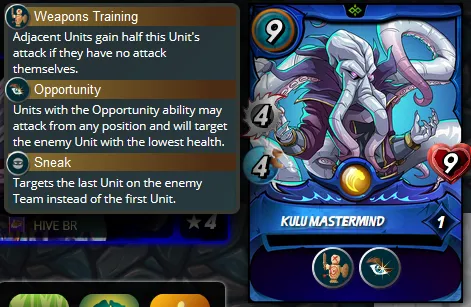
The other monster that received the attack attribute was Baakjira. He's an excellent tanker, and in this case, even if he receives a Meele attack, he still receives attacks from monsters with Snipe, so he could hold off the opposing team.
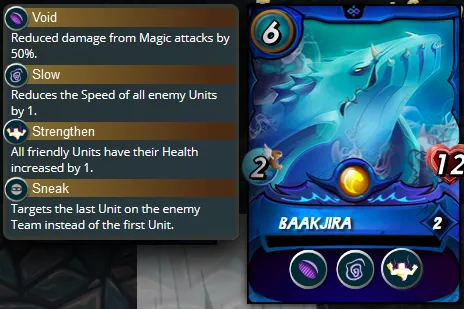
Right next to it, I placed the River Hellondale. As well as resurrecting the first monster to be killed, she provides 1 extra point of Meele attack for all those with this type of attack.
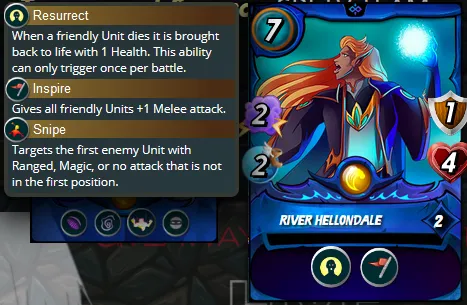
In penultimate position came the Axemaster, one of my favorite Ranges. His sole mission was to defeat as many monsters as possible.
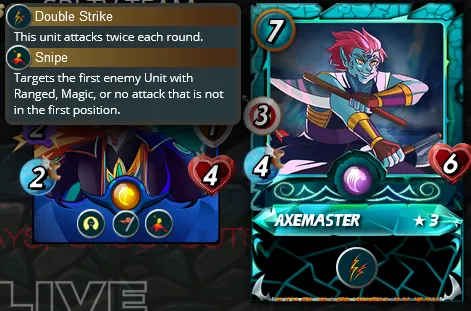
And finally, the Diemonshark, strategically positioned to hold off the opponent's Meeles.
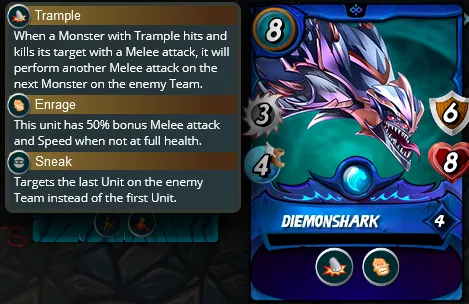
With this, I had an extremely powerful team, both in attack and defense, as you can see in the image below.
My opponent used some similar cards, but the positioning was a bit different.

In the first round, an opposing monster is killed, providing Martyr for his adjacent ones, with a good increase in attributes. Although they were extremely strong in attack, they were weak in life and armor, which made them vulnerable to my team's attack.
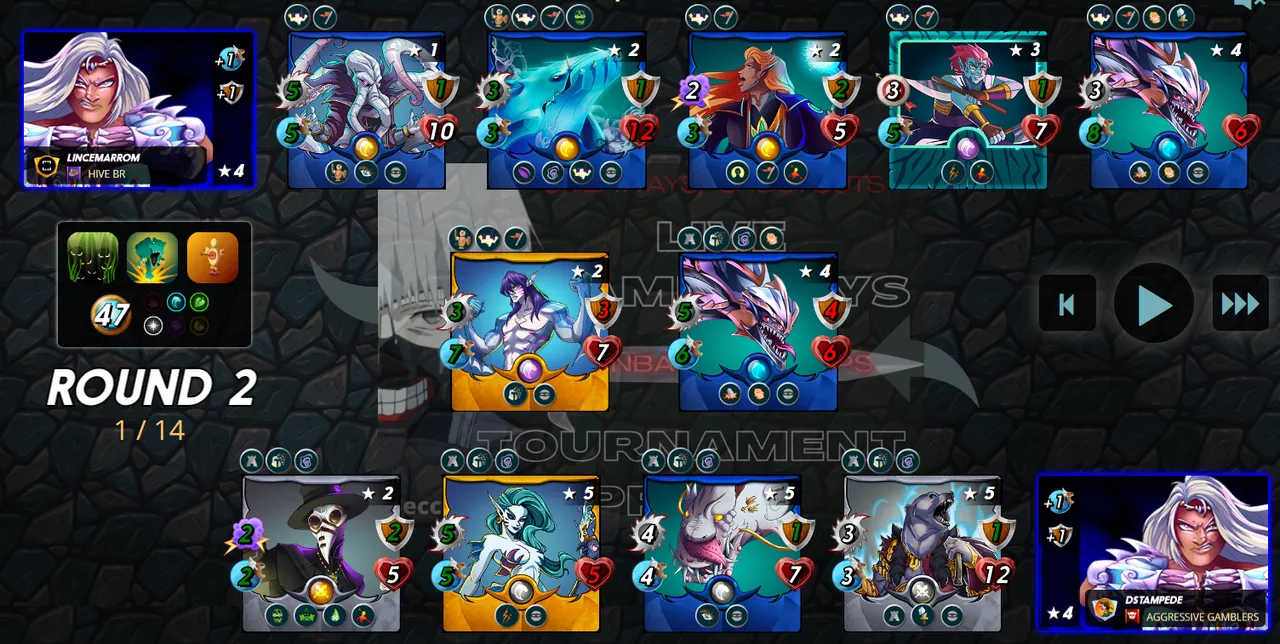
This can be seen at the end of the second round, when his second monster falls, while my entire team was still alive. My Diemonshark was killed, but resurrected by River Hellondale.
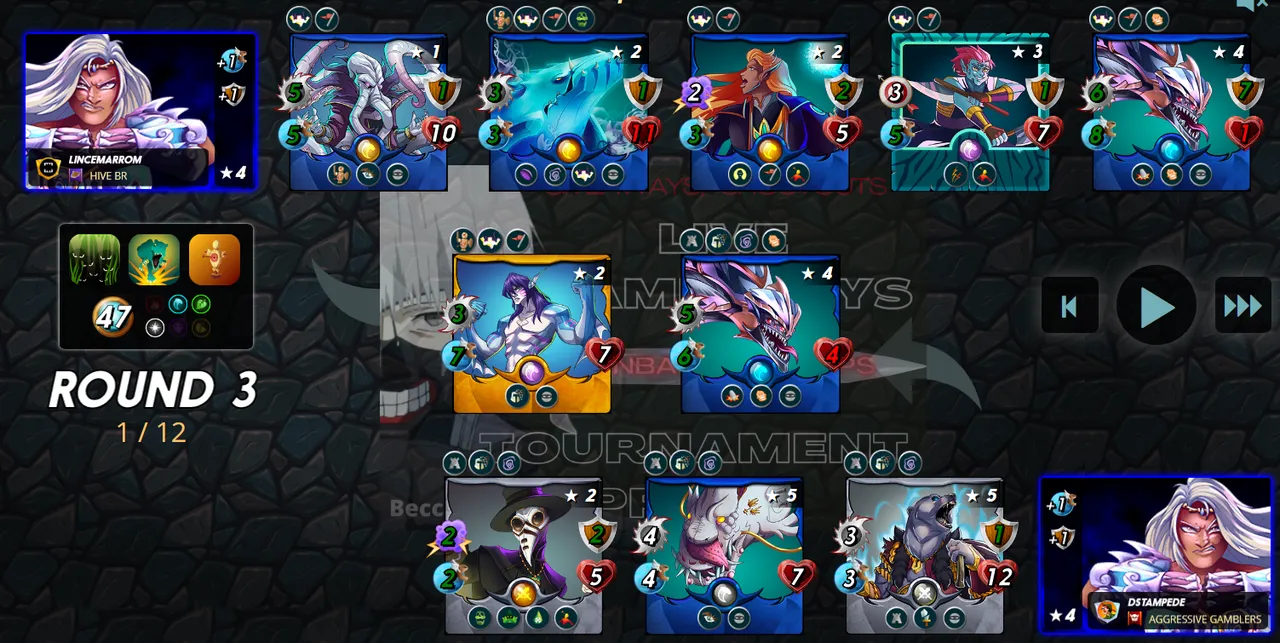
By the end of the third round, victory was already decreed for my side.

Fun fact: look at my opponent's nickname hahaha
Click here to watch the full battle!

Conclusion
The Stampede ruleset hardly has some effect on the battle itself, as you have to check all the others that will come along to formulate the best strategy. As such, it often ends up being ignored, because the chance of the phenomenon of performing more than one attack followed by Trample is rare, since it is necessary to eliminate the attacked monster for the effect to be activated.
It is possible to eliminate the first monster with an attack and activate Trample once, since it will be the target of most of the team, but to be able to eliminate the second with an attack and thus activate Trample a second time in a row is extremely difficult.
All the images are from @Splinterlands
Divider By: @freeztag
Are you not playing Splinterlands yet? Click HERE and play with me!

Português
Introdução
O Trample é uma habilidade extremamente interessante, que tem a característica de funcionar apenas para as cartas que possuem ataque corpo a corpo, isto é, os Meeles.

Ela faz com que quando um monstro adversário é eliminado pelo detentor da habilidade, um ataque extra possa ser realizado no próximo monstro da linha. Isso quer dizer que, caso essa situação ocorra com uma carta que estiver na última posição em campo, esse ataque adicional não se concretizará.
De qualquer forma, vale a pena utilizá-los sempre que possível. De preferência, colocando um monstro com Taunt na linha de trás, para segurar a equipe adversária para que eles sobrevivam por mais tempo, e assim ter mais chances de conseguir realizar mais ataques.
Porém, já pensou se esses ataques extras pudessem ser realizados várias vezes em seguida? É o que pode ocorrer quando a regra Stampede está presente.

Caso cada um dos monstros atacados seja eliminado e o atacante possua Trample, o número de ataques será ilimitado até que algum deles consiga segurá-lo.

Análise da batalha
Na batalha que eu encontrei essa regra, haviam outras duas:
Super Sneak: todos os monstros tipo Meele, recebem a habilidade Sneak, atacando o último monstro da linha de trás.

Target Practice: monstros tipo Range e Mágicos, possuem a habilidade Snipe, fazendo assim com que ataquem o primeiro monstro da linha de trás que não é Meele.

Com isso, haviam diversas coisas que eu precisava me atentar:
Primeiro: a regra de batalha do desafio semanal se tornaria inútil, já que o Trample ataca o próximo monstro que estiver em campo, porém se esse monstro for o último da linha de trás, não há nenhum outro para atacar após ele, invalidando a habilidade e consequentemente a regra. A única forma de funcionar, seria colocar um monstro com Trample na linha de frente ou o último monstro da linha de trás ser um com a habilidade Camouflage, fazendo com que o penúltimo seja atacado, e assim havendo a chance disso acontecer. No entanto, não achei tão interessante fazer isso.
Vale ressaltar que a habilidade Sneak sobrepõe todas as outras habilidade que os Meeles possuem, então todos atacam o último monstro da linha de trás, independente de qual habilidade possuem.
Segundo: todos os monstros da linha de trás iriam atacar o time adversário da linha de trás também, nesse caso eu não precisaria me preocupar tanto com a linha de frente, já que apenas a outra carta que estivesse na mesma posição iria atacá-lo.
A quantidade de mana era decente. 47 pontos, o que permitia montar um bom time, com diversos monstros de mana alta. A quantidade de Splinters estava limitada a 3: Água, Terra e Life.

Decidi jogar com água, selecionando a invocadora Kelya Frendul. Além de fornecer um ponto de armadura para cada monstro, aumenta também em 1 ponto a velocidade de ambos.

Na frente, coloquei o Noa The Just, que remove 2 pontos de armadura o time inimigo.

Logo atrás, veio o Kulu Mastermind. Minha ideia era colocar 2 monstros sem nenhum tipo de ataque de seu lado, assim eles ganham metade de seu ataque, graças a habilidade Weapons Training. Mesmo sendo Meele, o fato da regra de batalha citada anteriormente fazia com que atacassem de qualquer posição em campo.

O outro monstro que recebeu o atributo de ataque foi o Baakjira. Ele é um excelente tanker, e nesse caso, mesmo que ele receba ataque tipo Meele, ainda continua recebendo ataques de monstros com Snipe, fazendo com que pudesse segurar o time adversário.

Logo ao seu lado, coloquei a River Hellondale. Além de ressuscitar o primeiro monstro a ser morto, fornece 1 ponto extra de ataque Meele para todos os que possuem esse tipo de ataque.

Na penúltima posição, veio o Axemaster, um dos meus Ranges favoritos. Sua única missão era derrotar a maior quantidade de monstros possível.

E por fim, o Diemonshark, posicionado estratégicamente para segurar os Meeles do oponente.

Com isso, eu havia um time extremamente poderoso, tanto no ataque, quanto na defesa, como você pode ver na imagem abaixo.
Meu oponente veio com algumas cartas iguais, mas o posicionamento delas foi um pouco diferente

Na primeira rodada, um monstro adversário é morto, fornecendo Martyr para os seus adjacentes, tendo um bom acréscimo nos atributos. Apesar de serem extremamente fortes no ataque, eram fracos em questão de vida e armadura, o que os tornavam vulneráveis ao ataque do meu time.

Isso pode ser visto ao final da segunda rodada, quando o segundo monstro dele cai, enquanto todo o meu time estava vivo ainda. Meu Diemonshark foi morto, mas ressuscitado pela River Hellondale.

Ao final da terceira rodada, a vitória já estava decretada para o meu lado.

Fato curioso: veja o nome do meu oponente hahaha
Clique aqui para ver a batalha completa!

Conclusão
A regra de batalha Stampede, dificilmente tem algum efeito sobre a batalha em si, sendo necessário checar todas as outras que virão em conjunto para formular a melhor estratégia. Sendo assim, muitas vezes ela acaba sendo ignorada, pois a chance do fenomêno de realizar mais de um ataque seguido por Trample é raro, já que é necessário eliminar o monstro atacado para que o efeito seja ativado.
É possível de eliminar o primeiro monstro com um ataque e ativar o Trample uma vez, já que ele será o alvo da maior parte do time, mas para conseguir eliminar o segundo com um ataque e assim ativar o Trample uma segunda vez em seguida, é algo extremamente difícil de acontecer.
Todas as imagens são do: @Splinterlands
Divisor do: @freeztag
Não joga Splinterlands ainda? Clique AQUI e venha jogar comigo!
